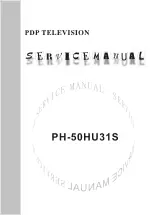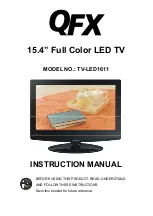
Service Modes, Error Codes, and Fault Finding
EN 12
FTP2.2U AA
5.
•
Short for a moment the two solder pads on the SSB with
the indication "SAM". Depending on the software version,
it is possible that a service warning will appear. You can
continue by pressing any digit key on the RC.
•
Use the DST-emulation feature of ComPair.
After activating this mode, “SAM” will appear in the upper right
corner of the screen.
Contents of SAM:
•
OPERATION HOURS.
Displays the accumulated total of
operation hours (not the standby hours).
•
SW VERSION INFO.
–
ROM VERSION.
Displays the date of the software and
the software version of the ROM
(
ex.
TX21US_1.0_01234 = AAAABB_X.Y_NNNNN).
•
AAAA
= the chassis name.
•
BB
= the region: EU= Europe, AP= Asia Pacific
PAL/Multi, AN= Asia Pacific NTSC, US= USA, LT=
LATAM.
•
X.Y
= the software version, where X is the main
version number (different numbers are not
compatible with one another) and Y is the sub
version number (a higher number is always
compatible with a lower number).
•
NNNNN
= last five digits of 12nc code software.
–
FBX Version.
Displays the software version of the
FBX
–
SW VERSION EPLD
. Displays the software version of
the EPLD.
•
ERRORS.
(followed by maximal 10 errors). The most
recent error is displayed at the upper left (for an error
explanation see paragraph “Error Codes”).
•
DEFECTIVE MODULE.
Here the module that generates
the error is displayed. If there are multiple errors in the
buffer, which are not all generated by a single module,
there is probably another defect. It will then display the
message “UNKNOWN” here.
•
RESET ERROR BUFFER.
When you press the “OK”
button, the error buffer is reset.
•
ALIGNMENTS.
This will activate the “ALIGNMENTS” sub-
menu.
•
DEALER OPTIONS.
Extra features for the dealers.
•
SERVICE OPTIONS.
Extra features for Service.
•
INITIALISE NVM.
When an NVM was corrupted (or
replaced) in the former EM3 chassis, the microprocessor
replaces the content with default data (to assure that the
set can operate). However, all pre-sets and alignment
values are gone now, and option numbers are not correct.
Therefore, this was a very drastic way. In this chassis, the
procedure is implemented in another way: The moment the
processor recognises a corrupted NVM, the “initialise
NVM” line will be highlighted. Now, you can do two things
(dependent of the service instructions at that moment):
–
Save the content of the NVM via ComPair for
development analysis,
before
initialising. This will give
the Philips Service department an extra possibility for
diagnosis (e.g. when Development asks for this).
–
Initialise the NVM (same as in the past, however now it
happens conscious).
•
STORE.
All options and alignments are stored when
pressing the “OK”-button
•
FUNCTIONAL TEST.
All devices are tested via the “OK”
button. Eventual errors are displayed in the error buffer.
The error buffer is not erased, the content returns when this
test is terminated.
•
DAILY MENUS.
With the “OK” button, you can go to the
normal user menu. SAM is still active in the background.
With the “MENU” button, you return from the user menu to
SAM menu. This feature can be helpful to quickly change
some settings in the user menu.
•
SW MAINTENANCE.
–
UPGRADE.
More info see paragraph Software
downloading.
•
Operation Hr PDP.
Displays the accumulated total of
operation hours of the PDP.
How to navigate
•
In SAM, you can select the menu items with the “CURSOR
UP/DOWN” key on the RC-transmitter. The selected item
will be highlighted. When not all menu items fit on the
screen, move the “CURSOR UP/DOWN” key to display the
next/previous menu items.
•
With the “CURSOR LEFT/RIGHT” keys, it is possible to:
–
(De) activate the selected menu item.
–
Change the value of the selected menu item.
–
Activate the selected submenu.
How to exit SAM
Use one of the following methods:
•
Press the “MENU” button on the RC-transmitter, or
•
Switch the set to STANDBY via the RC-transmitter, or
•
Press the “EXIT” button on the DST.
5.2.3
Customer Service Mode (CSM)
Purpose
When a customer is having problems with his TV-set, he can
call his dealer. The service technician can than ask the
customer to activate the CSM, in order to identify the status of
the set. Now, the service technician can judge the severity of
the complaint. In many cases, he can advise the customer how
to solve the problem, or he can decide if it is necessary to visit
the customer.
The CSM is a read only mode; therefore, modifications in this
mode are not possible.
How to activate CSM
Use one of the following methods:
•
Press the “MUTE” button on the RC-transmitter
simultaneously
with the “MENU” button on the TV (top
control) for at least 4 seconds.
•
Key in the code “123654” via the standard RC transmitter.
Note
: Activation of the CSM is only possible if there is no (user)
menu on the screen!
How to navigate
By means of the “CURSOR-DOWN/UP” knob on the RC-
transmitter, you can navigate through the menus.
Contents of CSM
CUSTOMER SERVICE MENU 1
•
SW VERSION (example: TX21US_1.0_01234).
Displays
the built-in software version. In case of field problems
related to software, software can be upgraded (for more
details, see paragraph Software downloading). You will
find details of the software versions in the chapter
“Software Survey” of the “Product Survey - Color
Television” publication. This publication is generated four
times a year.
•
FEATURE BOX
. The 12NC-number of the built-in Feature
Box software.
•
SET TYPE.
This information is very helpful for a helpdesk/
workshop as reference for further diagnosis. In this way, it
is not necessary for the customer to look at the rear of the
TV-set.
•
CODE 1.
Gives the latest five errors of the error buffer. As
soon as the built-in diagnose software has detected an
error the buffer is adapted. The last occurred error is
displayed on the leftmost position. Each error code is
displayed as a 3-digit number. When less than 10 errors
occur, the rest of the buffer is empty (000). See also
paragraph Error Codes for a description.
•
CODE 2.
Gives the first five errors of the error buffer. See
also paragraph Error Codes for a description.













































